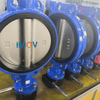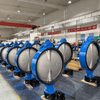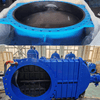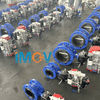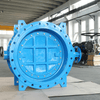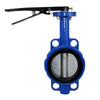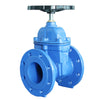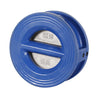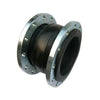¿Qué es una válvula de retención silenciosa?
La válvula de retención silenciosa es una solución de alto rendimiento diseñada específicamente para minimizar el golpe de ariete y reducir el ruido del sistema. Es ideal para aplicaciones de suministro de agua, sistemas de climatización (HVAC), protección contra incendios y tuberías industriales.
A diferencia de las válvulas de retención de clapeta tradicionales, que producen un fuerte "golpe" al cerrarse, la válvula de retención silenciosa cuenta con un mecanismo de cierre asistido por resorte. Esto permite que el disco se cierre antes de que se produzca el flujo inverso, reduciendo significativamente el impacto hidráulico y el ruido. El resultado es un funcionamiento del sistema más silencioso, seguro y fiable.

Composición de la válvula de retención silenciosa
La válvula de retención silenciosa consta de los siguientes componentes principales:
- Cuerpo de la válvula
- Asiento
- Desct
- Cuerpo guía
- Bujes
- Primavera
Su flujo interno está optimizado para reducir la pérdida de presión, y el recorrido del disco es corto, lo que garantiza un cierre rápido al detenerse la bomba, evitando así el golpe de ariete. Esto la hace especialmente adecuada para su instalación en la descarga de las bombas.
Principio de funcionamiento de la válvula de retención silenciosa
- Flujo hacia adelante: cuando el medio (como agua, aire o aceite) fluye en la dirección correcta, el disco de la válvula se abre automáticamente bajo la presión del fluido, lo que permite el paso libre.
- Prevención del flujo inverso: cuando el flujo se detiene o se invierte, el disco se cierra rápidamente con la ayuda de:
- Asistencia de resorte: el resorte incorporado aplica contrapresión al disco, acelerando el cierre.
- Diseño de amortiguación opcional: algunos modelos utilizan una acción de cierre de dos etapas (cierre rápido seguido de cierre suave) para eliminar el impacto del apagado repentino.
- Reducción de ruido: El diseño de la válvula incorpora geometría de disco optimizada, tensión de resorte y materiales de sellado para minimizar la vibración y el sonido durante el cierre.
Este diseño de equilibrio dinámico garantiza un rendimiento estable independientemente de las fluctuaciones de presión en la entrada.
Ventajas de la válvula de retención silenciosa
- Elimina el golpe de ariete
El cierre con resorte evita el flujo inverso repentino, lo que reduce los picos de presión y protege los componentes del sistema. - Operación silenciosa
Diseñada para entornos sensibles al ruido (hospitales, edificios residenciales, hoteles), esta válvula funciona con poco o ningún ruido durante el cierre. - Estructura compacta, instalación flexible
En comparación con las válvulas de retención oscilantes, los modelos silenciosos son más compactos y se pueden instalar horizontal o verticalmente (según modelos específicos). - Previene la contaminación por reflujo
El cierre rápido garantiza que no haya flujo inverso, evitando la contaminación o el mal funcionamiento del sistema. - Bajo mantenimiento, larga vida útil
Con una estructura interna simple, robusta y menos partes móviles, estas válvulas ofrecen alta durabilidad y bajos costos de mantenimiento. - Amplia gama de aplicaciones
Adecuado para usar con agua fría y caliente, sistemas HVAC, aire comprimido y líneas de descarga de bombas, especialmente donde el control del ruido y el golpe de ariete son fundamentales.

Comparación del rendimiento de reducción de ruido
|
Solicitud |
Nivel de ruido (dB) |
Descripción |
|
Válvula de retención oscilante tradicional |
60–80 dB |
Puede producir un fuerte "bang" bajo inversión del flujo |
|
Válvula de retención silenciosa |
30–50 dB |
Funcionamiento silencioso, “clic” suave o casi silencioso |
|
Biblioteca (referencia) |
~30 dB |
Extremadamente silencioso |
|
Conversación normal en interiores |
50–60 dB |
Para comparar |
|
Ruido de calle concurrida |
70–90 dB |
Ruidoso, disruptivo |
Factores que afectan el rendimiento de ruido de la válvula de retención silenciosa
- Velocidad de flujo: Cuanto mayor sea la velocidad del flujo, más pronunciada será la diferencia en la reducción de ruido entre las válvulas de retención silenciosas y las convencionales.
- Ubicación de instalación: Instalar la válvula más cerca de la salida de la bomba produce una mejor prevención del golpe de ariete.
- Fluctuación de presión del sistema: las válvulas de retención silenciosas funcionan especialmente bien en sistemas con cambios frecuentes de presión.
- Calidad del material: Los materiales de primera calidad, como resortes de acero inoxidable y asientos de goma, contribuyen tanto al control del ruido como a la longevidad de la válvula.
Instalación de válvula de retención silenciosa

- Coloque la válvula entre las bridas de la tubería, utilizando juntas adecuadas para garantizar un sellado hermético.
- Asegúrese de que la distancia entre las bridas coincida exactamente con la longitud de la válvula. No fuerce la válvula al ajustar los pernos.
- No suelde bridas a la tubería después de haber instalado la válvula.
- Asegúrese de que el centro de la válvula esté perfectamente alineado con la tubería para evitar desalineación o daños por tensión.
- Para minimizar la vibración, considere instalar juntas flexibles antes o después de la válvula.
- Deje suficiente espacio libre, ya que algunos discos de válvulas pueden sobresalir del cuerpo durante el funcionamiento.
Nota: Esta válvula es unidireccional. Siga la flecha de dirección de flujo en el cuerpo de la válvula durante la instalación.
Acerca de Union Valve
En Union Valve, nos especializamos en el diseño y la fabricación de soluciones de válvulas de alta calidad. Nuestra gama de productos incluye válvulas de mariposa, válvulas de compuerta, válvulas de bola, válvulas de retención, filtros, válvulas de globo y juntas flexibles.
Ofrecemos productos estándar y soluciones personalizadas adaptadas a sus necesidades específicas. Si busca válvulas fiables y duraderas para su próximo proyecto o necesita asesoramiento experto, nuestro equipo técnico está aquí para ayudarle.
¡Contáctanos hoy para obtener más información!
Artículo relacionado:
- La diferencia entre una válvula de retención y una válvula unidireccional
- Cómo elegir la válvula de retención adecuada para su sistema
- Válvulas de compuerta y de retención: una guía comparativa clara
-
Publicado en
Silent Check Valve
